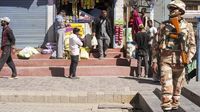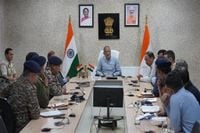Ladakh, a region renowned for its serene landscapes and resilient communities, found itself at the center of national attention this past week after violent protests demanding statehood erupted into chaos, leaving four civilians dead and scores injured. The unrest, which began on September 24, 2025, marked what Tashi Gyalson, Chief of the Ladakh Autonomous Hill Development Council, described as the region's "darkest day in history," according to Devdiscourse.
What started as a peaceful demonstration, spearheaded by climate activist and Ladakh statehood campaigner Sonam Wangchuk, quickly spiraled out of control. Gyalson, in his public statement, criticized both the police and the protestors for the escalation, demanding accountability and transparency from all involved. He condemned what he called the excessive use of force by police when the situation deteriorated, while also acknowledging that misinformation and provocative rhetoric had disrupted the initially hopeful talks with the government over constitutional safeguards for Ladakh.
As reported by ANI and The Hindu, the violence broke out around 12:30 p.m., with approximately 6,000 demonstrators gathering at Wangchuk’s protest site in Leh. Anti-social elements reportedly joined the crowd, and the protest soon devolved into widespread damage to government buildings and the local BJP party headquarters. The unrest intensified following the arson attack on the BJP office. The violence was brought under control by 4 p.m., but not before 80 civilians and 70 to 80 security personnel, including CRPF jawans and Ladakh police, had sustained injuries. One security jawan suffered a serious spine injury, and a building housing four policewomen was set ablaze. Among the wounded were three Nepali citizens who suffered bullet injuries.
According to Director General of Police S.D. Singh Jamwal, security forces responded with gunfire under the right to self-defense and to protect national property, in line with standard operating procedures. "Security forces fired under the right to self-defence and protection of national properties, which is part of the Standard Operating Procedure (SOP)," Jamwal stated at a press conference following the incident.
The aftermath saw a heavy-handed response from authorities. A total of 44 individuals were detained, including a Pakistani intelligence official accused of transmitting protest footage to Pakistan. Five to six ringleaders, including Wangchuk, were taken into custody under the National Security Act (NSA). Wangchuk, initially held in Leh, was transferred to Jodhpur jail. Police accused him of "vitiating the peaceful atmosphere of the region," attempting to derail scheduled talks between the Centre and local representatives, and making provocative speeches referencing recent protests in Nepal, Bangladesh, and Sri Lanka. His visit to a Pakistan-based climate conference and alleged misuse of foreign funds are also under investigation.
The Ladakh administration justified Wangchuk’s detention, stating it was necessary to prevent further actions prejudicial to public order. A government spokesperson explained that Wangchuk’s speeches and videos were "prejudicial to the security of the State and detrimental to maintenance of peace and public order and services essential to the community." The funerals of the four deceased civilians were scheduled for September 28 and 29, with police allowing only close relatives to attend, in an effort to prevent further unrest.
In the wake of the violence, authorities imposed strict security measures under Section 163 of the Bharatiya Nagarik Suraksha Sanhita, restricting public gatherings in Leh. Curfew was enforced for four days, with a phased relaxation on September 27—first from 1 p.m. to 3 p.m. in the old city, then from 3:30 p.m. to 5 p.m. in the outskirts—allowing residents to purchase essentials. Officials reported that the curfew relaxation passed off peacefully, a testament to the restraint and maturity shown by the people of Leh during a tense period.
The unrest also prompted a high-level security review meeting on September 27, chaired by the Lieutenant Governor of Ladakh, Kavinder Gupta, as reported by KNS. The meeting included Chief Secretary Dr. Pawan Kotwal, DGP S.D. Singh Jamwal, and senior officers from the Army and Indo-Tibetan Border Police. The focus was on current deployments, emerging challenges, and coordinated strategies to ensure public safety and peace.
Lieutenant Governor Gupta praised Leh residents for their composure during the relaxation of restrictions and emphasized the importance of strict law and order, seamless coordination among civil and security agencies, and timely intelligence sharing. He reaffirmed the government's commitment to the security, stability, and welfare of Ladakh's people, urging vigilance against anti-social and anti-national elements. "Every step will be taken to protect the security, stability, and overall welfare of the people of Ladakh," Gupta assured. He also called for public cooperation with the administration to preserve peace and normalcy.
The events of September 24 were unprecedented in Ladakh’s recent history, with DGP Jamwal noting, "Such an unprecedented incident never has never taken place in the history of Ladakh." He appealed to local residents to cooperate with authorities in reestablishing peace, highlighting that the region had always maintained a cooperative relationship with law enforcement prior to this incident.
Meanwhile, the broader context of the protests cannot be ignored. The demand for statehood and constitutional safeguards for Ladakh has been a simmering issue since the region was designated a Union Territory in 2019. Previous negotiations between the Centre’s High Powered Committee and Ladakhi groups had yielded significant concessions, including 85% reservation of jobs for locals, one-third reservation for women in local councils, and the official recognition of Purgi and Balti languages. Yet, many activists and local leaders argue these measures fall short of the constitutional protections they seek.
The situation remains tense but cautiously hopeful. On September 27, Lieutenant General Pratik Sharma, General Officer Commanding-in-Chief of the Indian Army’s Northern Command, met with Lieutenant Governor Gupta to discuss the prevailing security scenario and the need for enhanced coordination between civil administration and armed forces. Both sides stressed the importance of preparedness and synergy in addressing any future contingencies, underscoring the ongoing volatility in the region.
As Ladakh grapples with the aftermath of violence and the imposition of new security protocols, questions linger about the path forward. The government’s call for a proactive, coordinated, people-centric approach to law and order is clear, but the underlying grievances that drove thousands to the streets remain unresolved. For now, the region waits—hoping for dialogue, accountability, and a return to the peace that has long defined its character.

